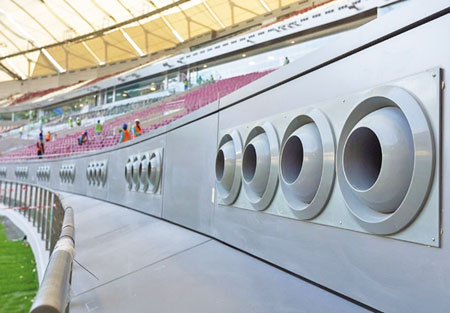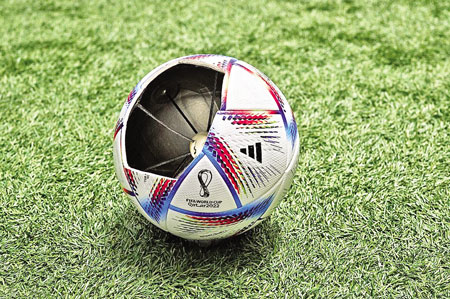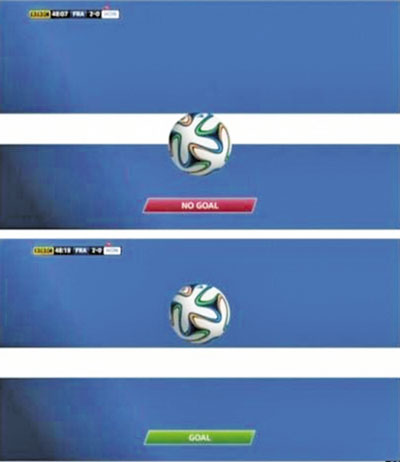Advanced technologies have dominated the past couple of FIFA World Cups. Back in 2010, when Qatar was selected to host the 2022 World Cup, the region started building Vision 2020-23 to outline FIFA's commitment to using technology in football, report agencies.
The idea is to leverage different types of technologies to improve the game experience for fans on and off the field. Some of these technologies include-AI (Artificial Intelligence) assistive offsite detection, assistive technology for visually-impaired fans, stadium cooling technology, and the ball itself has sensors to detect peak game speeds.
Let's take a look at the technological innovations that comforted the fans, players.
 Advanced stadium cooling technology
Advanced stadium cooling technology
Players and fans in Qatar find themselves in a comfortable atmosphere because 7 out of 8 stadiums during the Qatar 2022 World Cup are fully fitted out with advanced air conditioning technology to maintain temperate conditions inside the stadiums.
Air is pumped out from vents in the corners of the stadium and from beneath the seats, with sensors that will help stabilise the temperature and adjust air flows for seats in the shade and others under the sun.
The rising air will be sucked into the stadium's cooling system, purified using water kept at 7°C, and then pumped back into the stadium.
The technology is powered by solar energy and filters air from outside which is then pumped into the field and stands.
AI Rihla: Sensor soccer ball
 The official Qatar 2022 World Cup ball, Al Rihla ("the journey"), plays a major role in applying the offside detection technology, as a sensor installed inside the ball's centre accurately determines the location of the ball at all times, and therefore be able to acknowledge the occurrence of an offside position or not. The sensor reports precise location data on the ball 500 times per second, according to the company, helping referees make more precise calls.
The official Qatar 2022 World Cup ball, Al Rihla ("the journey"), plays a major role in applying the offside detection technology, as a sensor installed inside the ball's centre accurately determines the location of the ball at all times, and therefore be able to acknowledge the occurrence of an offside position or not. The sensor reports precise location data on the ball 500 times per second, according to the company, helping referees make more precise calls.
The sensor offers video assistant referees instantaneous information to help optimise their decision-making.
Al Rihla was produced by the German company Adidas, who claim it is the "fastest and most accurate" ball in World Cup history.
The ball is used in all of the tournament's 64 matches, and feeds information back to a data nerve center, which officials can use to track statistics and monitor game play.
FIFA Player app
The FIFA Player App developed by FIFA in collaboration with FIFPRO is used for the first time in Qatar 2022 World Cup. The app gives players performance metrics and analysis, physical performance metrics, and enhanced football intelligence metrics such as line-breaking events, receiving locations and pressure being applied to the player in possession of the ball.
Semi-automated offside technology
FIFA has employed a new system to detect the position of the football and help referees make accurate, fast and reproducible offside decisions during the tournament With the help of 12 tracking cameras around the stadium and the Al Rihla ball, the technology provides an automatic offside alert to the Video Assistant Referee every time the ball is played to a player in an offside position. This reduces the dependence on protracted VAR replays to determine whether a player is offside or not.
 Assistive tech for visually-impaired fans
Assistive tech for visually-impaired fans
FIFA has employed Bonocle and Feelix for visually impaired football fans.
Doha-based Bonocle was founded in 2014 by Abdelrazek Aly and Ramy Soliman.
With the help of assistive technology and transcoding functionality, Bonocle helps individuals with visual impairments to enjoy and experience the World Cup like everyone else.
On the other hand, Feelix Palm developed by an Oxford-based company Feelix, uses tactile palm communicators to transmit braille-like messages to visually impaired fans during the matches.
Goal-line technology
As the name suggests, goal-line technology determines if the ball actually went inside the goal. As per football's rules, the football must completely go inside the goal line between the two poles, at any height below the crossbar.
Before the technology was in use, goals like the following would often not be given as referees could not determine if the ball had completely crossed the line during fast plays.